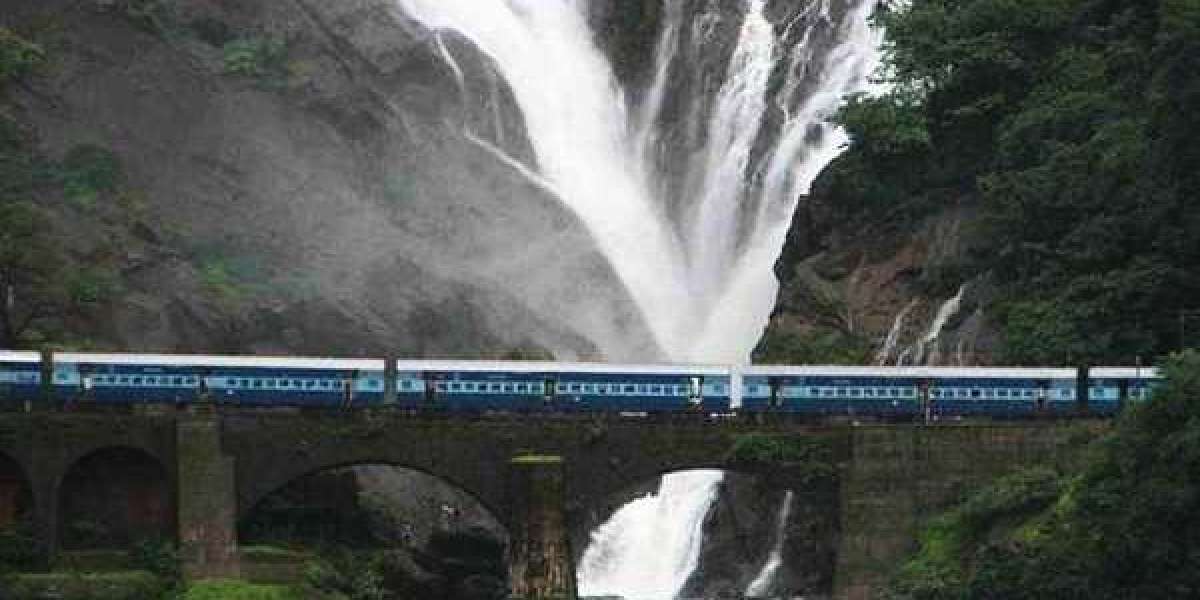Savour the glorious view of Dudhsagar, India. Beyond this splendid waterfall is nestled with interestingly rugged trekking routes, ancient glorious history, and attractions.
Introduction To Dudhsagar Falls
Dudhsagar Falls is a lake in India that measures 310 meters high from the Western Ghats of Goa. This truly calls for a breathtaking and mesmerizing look, meaning “a sea of milk” in Hindi. Because of the cascaded waters flowing down the face of the rocky cliffs in a foamy, milky flow, the waterfall gives a great place. Situated within Bhagwan Mahaveer Wildlife Sanctuary, the water body lies surrounded by dense forest, furnishing a beautiful landscape with plenty of biodiversity for its visitors. It is considered to be a paradise.
Apart from tigers, leopards, and several species of birds, the place offers a general view of wildlife. The adventure doesn't stop there; you, by trekking the forest, will come to reach the destination. Besides gushing streams and dense trees, a trek through the rugged terrain leads straight towards the waterfall. But you can also reach this beautiful waterfall by train, as it is also fed by the Konkan Railway. The great experience offers anything you need, either adventure through the jungle or just marveling at one of nature's finest spectacles. That experience is really going to stay with you for a long time. It is beautiful and majestic and is one of the finest natural dependencies of Goa.
Access And Location
Getting There
Dudhsagar Waterfall is situated just at the borders between Goa and Karnataka and is, therefore, very easy to access from many major cities.
Proximity to Major Cities:
Dudhsagar Waterfall would be about a 60-kilometer journey from the capital, Panaji of Goa. South Goa's Margaon is also almost 46 kilometers from a waterfall. For those residing close to the popular beaches of North Goa, a little longer distance of around 80 kilometers is required.
Transportation Modes:
- By Train: The most adventurous way would be a train trip along the Konkan Railway, passing right adjacent to the waterfall. The train twists and turns through dense forests and rugged terrain to offer a breathtaking view of the train's journey over the landscape.
- By Jeep Safari: It certainly makes for an adventure trip if you can reach the falls by Jeep Safari through the thick jungles. The bumpy path is the challenge, but it adds that thrill to travel, and you feel close to nature as you drive through the off-road trails.
Visiting Time
The best time for a tourist to visit and enjoy his/her sight of the waterfall and experience the whole lot would vary.
- Peak Season (October) to May: So what is the best time to see Dudhsagar Waterfall at its full grandeur? The dry months from October to May promise an excellent opportunity for great views of water flowing down the cliffs at their best, creating a magnificent sight. The best visibility, particularly post-monsoon, leaves behind a greener setting to view the waterfall.
- Softer Visits (Pre- or Post-monsoon): If quieter visits are your scientific way of reading and travel, you can have it just before or after the spell of rain. The place will still be beautiful but not very stormy; the crowd grows thinner and gives a peaceful visit. The landscape is so lively due to recent rains and is also a pretty good setting for any nature lover.
History of Dudhsagar
Dudhsagar has become not only a natural wonder but also enriching ties that mingle cultural and mythical aspects with its identity.
Cultural and Historical Importance: This waterfall is between Goa and Karnataka, so "Dudhsagar," meaning "sea of milk," is here for a reason corresponding not just to its look but also to the traditions of the localities. It officially became a pilgrimage point for most people in the region long ago, for them and many others. Its discovery is not so certain when it happened, but it has slowly become one of the key tourist spots in the past few decades, attracting people worldwide.
Folklore and legends: Dudhsagar is rife with myths that go toward building its mystique and cultural impact.
The Princess Legend: A most invoked legend about this waterfall is of a very beautiful princess bathing in the waterfalls of Dudhsagar. The story says that the princess would pour milk into the water while bathing because she was modest by nature and wanted to keep it flowing with the frothy milky look over the waterfall itself, creating what was believed to leave the mark or signature style of the falls.
Symbolic Importance: According to one version of the legend, milk pouring symbolizes purity and protection. Another version emphasizes the beauty and grace of the princess, but both of these myths make the waterfall more culturally important and add to the magic with which it is viewed, thus making Dudhsagar even in terms of being a beautiful place, a meeting point within nature and legend.
Geographical Features: The waterfall is situated in one of the world's most biodiversity hotspots, i.e., the Western Ghats.
Western Ghats Scenery: Bhagwan Mahavir Wildlife Sanctuary, which is considered part of a rich ecosystem, houses this waterfall. The region is characterized by steep, rocky terrains, thick forests, and winding streams cutting across the area, creating conditions suitable for the waterfall to form.
Height and Location of the Waterfall: 310 meters of lofty height make this waterfall thunder down the cliffs, thus being an attraction for all senses - sight and sound. The weighty scenery of greenery and the rugged terrain add to the beauty, making Dudhsagar one of the most striking features of the Western Ghats.
Environmental Importance: Dudhsagar, in fact, plays a stellar role in the important environmental health of the place by contributing to ecological balance.
Biodiversity of Western Ghats: This area of the waterfall state is surrounded by the Western Ghats, which are a UNESCO World Heritage Site and constitute an extremely diverse assemblage of plants and animals. It is geologically considered one of the loudest biodiversity hotspots on Earth, with the greatest number of endemics. Dense forests of Dudhsagar spot wildlife like tigers, leopards, elephants, and a number of birds.
Significance of Dudhsagar in Ecological Terms: This beautiful waterfall has some of the most vital functions, such as controlling the area's ecological balance. Monsoon rains are regulated through the Western Ghats, while this very waterfall sends tributaries towards the rivers and streams, aiding in the local water cycle.
Importance for Conservation: The conservation of this spectrum of rich ecosystems is very important for preserving biodiversity and giving the same advantage to the local people who are dependent on this water cycle, as well as to the wildlife. The role of Dudhsagar in terms of environmental significance is more than an ordinary natural wonder; it is a part of the Indian cultural and scenic heritage.
Check Out: One Day Trip From Bangalore | Trekking Near Bangalore | Two Day Trip From Bangalore
Activities Around The Waterfall
- Trekking and Hiking: The Trekking Experience: The Dudhsagar Waterfall Trek is an adventuresome, full unforgettable trekking experience for nature lovers and adventure enthusiasts. The route contains contorting trails in the forest, rough train tracks, and rocky paths. The journey tests your endurance, making it a moderately challenging hike, but the beauty surrounding you makes every step worthwhile.
- Natural Surroundings: During the trek through thick forests, one might come across different types of flora and birdlife, along with the soothing sounds of nature. The psychologist will find it very stimulating because the landscape changes from forest to an open view of hills and valleys.
- Getting to the Waterfall: The magnificent view of the Dudhsagar Waterfall, tumbling from the cliffs, adorns the hike after such a gratifying trek. The greenery surrounding these falls adds beauty to the peacefulness of the environment after one finishes trekking.
- Scenic: Dudhsagar Waterfall enables amateur and professional photographers to take innumerable photographs. The sharp white cascade against the lush greenery of the forest creates a truly awe-inspiring picture.
- Golden Hours: The most beautiful photographs can be clicked at sunrise or sunset when the most endearing of magical effects can be caused by the light falling on the waterfalls and the surrounding landscapes: a very soft sun will make a beautiful play of light and shadow with the mist of the waterfall.
- Nature's Details: There are other flora and fauna around the waterfall that will also contribute to additional photography opportunities. Various close-up captures of the very colorful plants up to wide-angle open fields covering great landscapes with all-around-the-world features provide a lot of scenarios to show nature's embodiment in different forms.
Attractions Nearby:
- Bhagwan Mahavir Wildlife Sanctuary: Situated close to Dudhsagar, this is a better retreat to delve into Goa's enchanting rich biodiversity. It has a large area-wide home to many wildlife such as bit or night prowlers like leopards, spotted deer, sambar, or boars.
- Bird Watching and Wildlife: In addition, this sanctuary from the splendid place is considered an ornithologist's paradise, as it houses sightings of some species, such as the Indian hornbill and Malabar trogon. Immersing in this sanctuary's diaphanous forests and cool lakes enables one to enjoy a true sense of solitude when reconnecting with the local wildlife in a natural, peaceful setting.
- Flora and Fauna: This park is also close to Dudhsagar, a different spectacular spot for nature lovers. It is an excellent habitat for different flora and fauna. The park houses different species, such as the Malabar giant squirrel and Indian gaur.
- Trekking and Exploring: It has innumerable hiking trails where the park can be explored by its rich ecosystems. Different habitats, like forests, streams, and rivers, follow these trails, allowing you to enjoy nature and wildlife spotting.
- Natural Beauty: This place's lush greenery and serenity make it right for anyone wanting to discover more of Goa's natural treasures. Be it on the trails or just soaking up the ambiance around, this park is a must see in anyone's visits to the area.
Tips for a safe and secure Trip:
- The Essentials for Trekking: First things first, be sure to load it to Dudhsagar for a full day spent outdoors. Take plenty of water with you as it is the tropics, and snack foods are good for energy on the trek. You should also wear good-quality trekking shoes for convenience and safety, considering that trails can be rocky and uneven.
- Swimwear and a camera: No visit to Dudhsagar is complete without splashing around in the cool pools at the foot of the falls, so bring your bathers along. After the sweaty trek, it's hard to resist a plunge into those heavenly clear waters. The views are immensely beautiful, so a trip to Dudhsagar is incomplete without capturing vivid shots since it's a photographer's paradise.
- Additional Things: You should bring a hat or sunscreen for sun protection on these trips if you hike midday. A light raincoat can also be handy in monsoon months when weather can change quickly.
- Safety Precautions: Beware of Slippery Grounds. Dudhsagar offers an experience full of beauty; it should be kept with that. The trekking may not be very pleasing, and the ground may be slippery, especially during or soon after the monsoon season, which turns the rocks into mud. Appropriate footwear should, therefore, be worn to minimize slipping incidence.
- Supervision for Children: If you visit with children, ensure they are supervised closely. Some portions of the trail are narrow and edge along steep drops, making extra vigilance necessary.
- Avoid Getting Too Close to the Falls: The waterfall is a big natural activity, although most want to rush nearer for better views or take photos; however, do not draw near the edge of the falls. The slippery rocks close to the edges become dangerous, and the heavy force of the water is sometimes too strong.
Conclusion:
A trip to Dudhsagar has been promised as an extraordinary stay within the nature panorama. You can enjoy your journey safely and comfortably with the right essentials- enough water, some snacks, really good trekking shoes, swimwear, and something to shoot. Not to forget, a hat and some sunscreen or a light raincoat in case of the tropical sun or the flutter before rain, even on that day of adventure. Hence, planning makes your day in Dudhsagar nothing; it's a scenic view with memories to treasure.
FAQs
- During monsoon season, is it safe to visit Dudhsagar waterfall?
The looming season is relatively dangerous for most travel enthusiasts since heavy rains make moving around in such places slippery. The safety and weather checks and thorough precaution wonders where possible.
- Can I take my vehicle directly to the waterfall?
There is no entry of vehicles to the waterfall. One must trek or take a jeep safari.
- What are the different entry fees into Dudhsagar?
The entry fees vary from season to season. They include jeep and safari rides.
- What are the things that I should wear when visiting Dudhsagar?
Dress comfortably and wear proper shoes, especially when wading through the trek.
- Are there places near Dudhsagar Waterfalls that provide accommodation?
Yes, resorts and guest houses close to town, including Mollem and Panaji, are available for people wanting to stay in the area.
- When would be an ideal time to Visit Dudhsagar Waterfalls?
Monsoon (June to September) is the season that truly makes Dudhsagar Waterfall look magnificent and overflowing. Another greatly preferable time to visit this waterfall is during winter months, which starts from October up to February, but it is not that great if someone really wants to see the waterfall in full glory since this time it is quite less flowing due to dry conditions.
- What trekking routes are there to Dudhsagar Waterfall?
This is the most popular trekking route; one can trek to Dudhsagar over Bhagwan Mahavir Wildlife Sanctuary. One must cover a distance of about 3-4 hours of round trip. It commences from Dudhsagar Railways Station and finally up to the waterfall, crossing thick forests and streams.
Another route is from Collem Village, which is quite easy and provides beautiful scenery.
- How can I reach the Dudhsagar Waterfalls?
To reach Dudhsagar waterfalls by train, take a train up to Dudhsagar Railway Station, then walk to the falls.
- By Car: Drive yourself to the adjacent village of Collem and arrange to hire a jeep or walk to the waterfall trail.
- By Bus: These township buses - Panjim and Margao - can take you to Collem, afterward one would require the choice of going via jeep or trekking to the destination.
- Can we swim in Dudhsagar waters?
Swimming in the waters of Dudhsagar Falls is not advisable. It is better to view from a distance. Because strong currents and a deep pool at the bottom make this area very dangerous for swimming. Thus, many tourists end up swept this way.
- What type of flora and fauna can be seen in Dudhsagar Waterfall?
Some of the animals frequently sighted by tourists are leopards, deer, monkeys, and wild boars. Other numerous birds are hornbill, kingfisher, and woodpecker near Dudhsagar Waterfall.
- What amenities can I find around Dudhsagar Waterfall?
These would include basic amenities like food stalls, small cafes, and toilet facilities near Collem Village and along the trekking routes. However, no luxurious facilities are available around the fall; therefore, it would be better to pack snacks, water, and other essentials before one heads out on the trek.
- How much time do I need to allot for Dudhsagard waterfall?
Tourists should plan at least half a day (4-5 hours) to enjoy the waterfall with the trek and some time to relax and watch the views. A full day is probably needed if you want to explore the nearby places or enjoy a jeep safari.
- What are the other areas and activities around Dudhsaghar Waterfall?
- Bhagwan Mahavir Wildlife Sanctuary: The diversity within the sanctuary.
- Mollem National Park: A haven for nature enthusiasts.
- Tambdi Surla Temple: Nearby ancient temple from the 12th century.
- Spice Plantations: Many spice farms around Collem are open for guided tours and showcase the region's agricultural wealth.
Trending Packages: Netravati Trek | Bandaje Falls Trek | Ettina Bhuja Trek | Gokarna Beach Trek | Kudremukh Trek | Tadiandamol Trek














